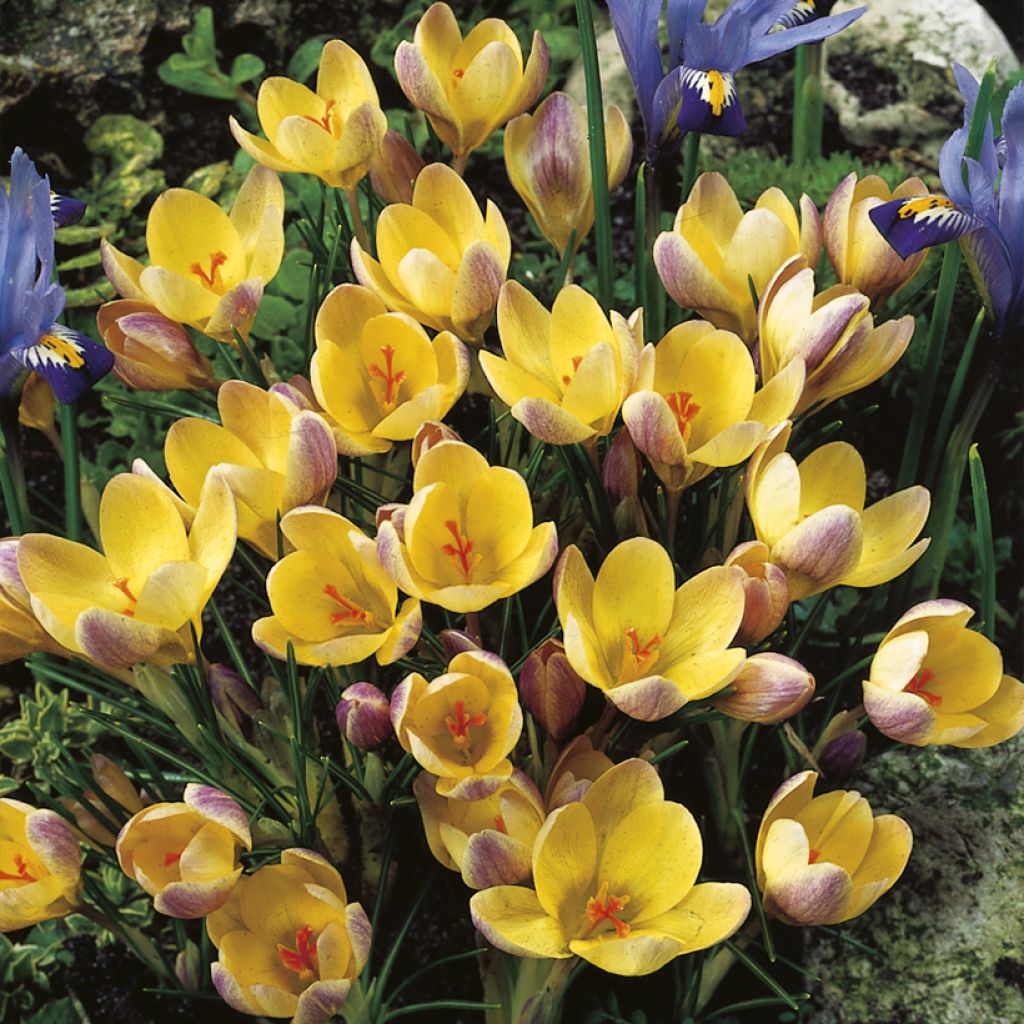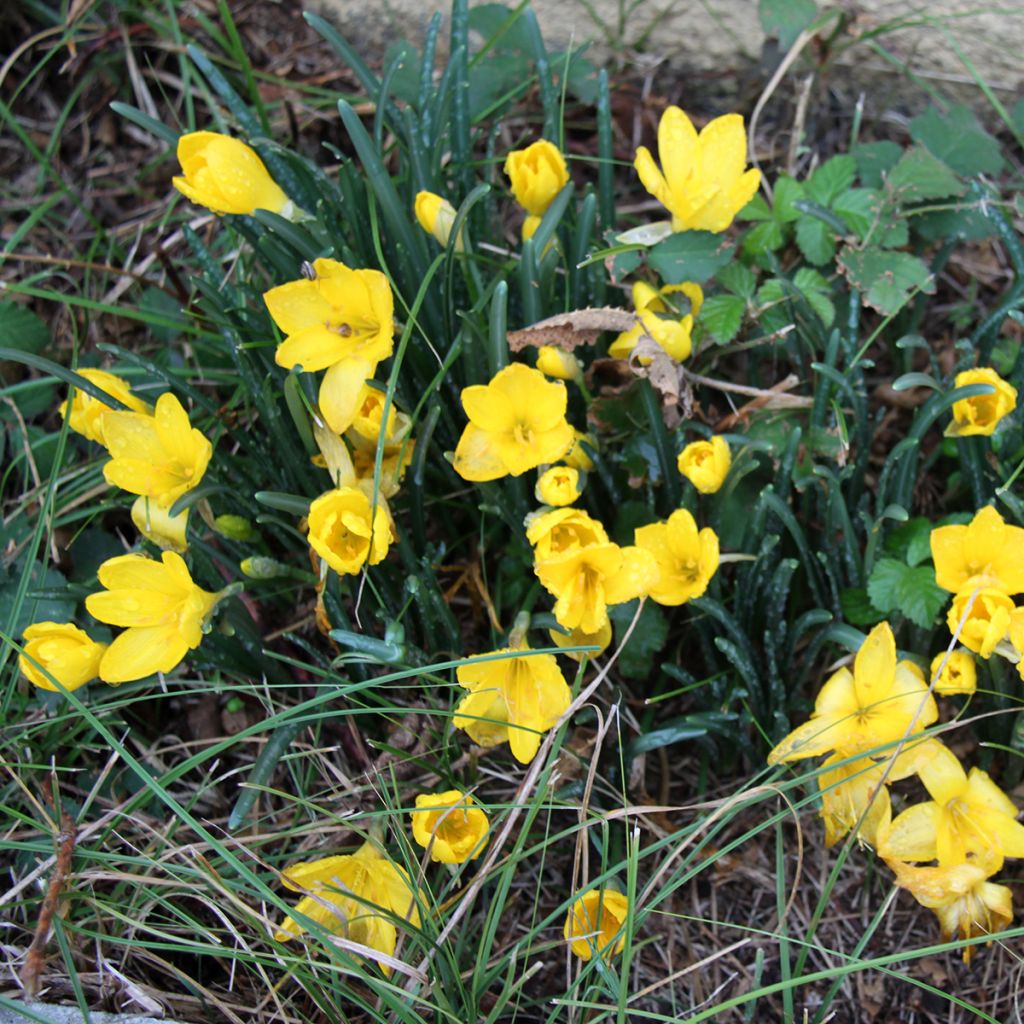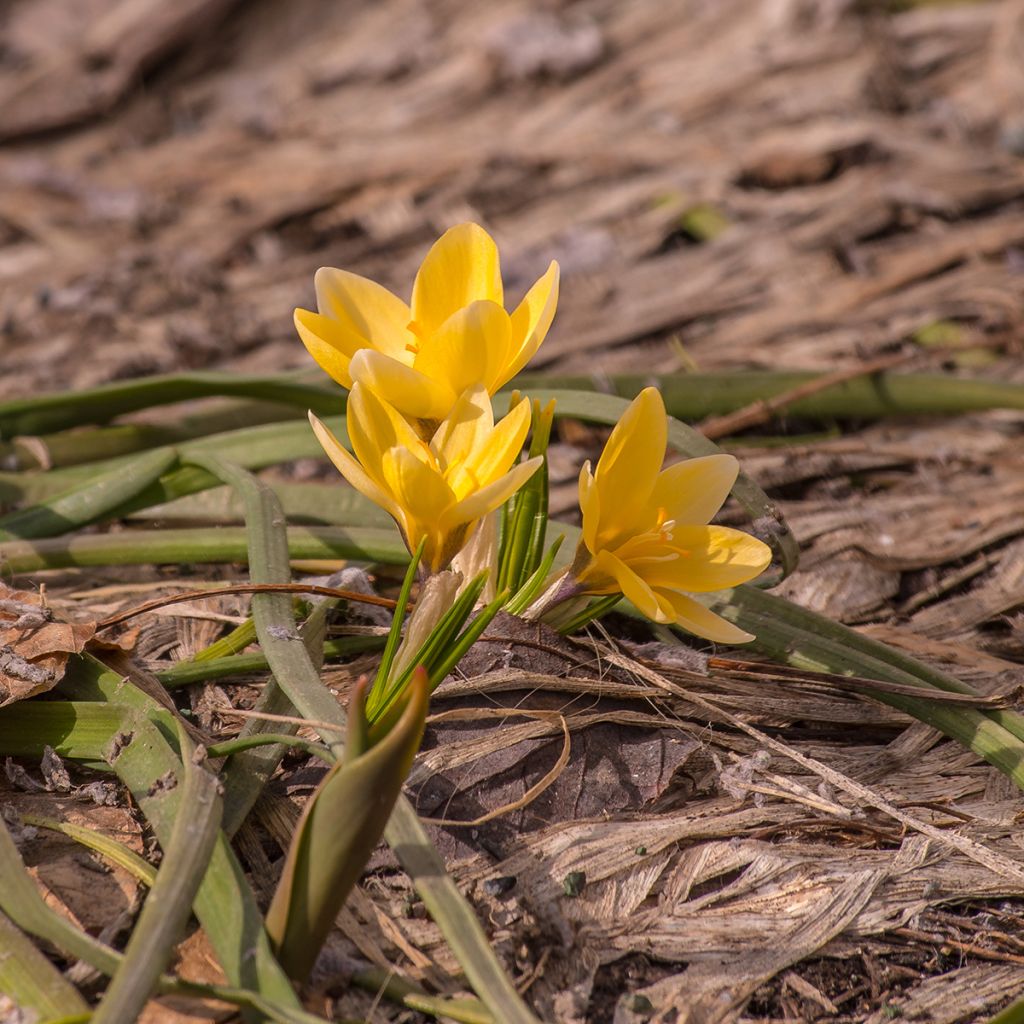

Crocus chrysanthus Advance


Crocus chrysanthus Advance


Crocus chrysanthus Advance
Crocus chrysanthus Advance
Crocus chrysanthus Advance
Snow Crocus, Golden Crocus
This plant carries a 6 months recovery warranty
More information
We guarantee the quality of our plants for a full growing cycle, and will replace at our expense any plant that fails to recover under normal climatic and planting conditions.
From €5.90 for pickup delivery and €6.90 for home delivery
Express home delivery from €8.90.
Does this plant fit my garden?
Set up your Plantfit profile →
Description
Crocus chrysanthus 'Advance' flowers very early in the season, at the end of winter, at the same time as the Siberian Squill. While its flowers are quite small, it produces several per bulb, and their beauty attracts all attention. The corolla is a tender yellow on the inside while the outside turns white with hints of purple. Easily naturalising in open ground, this small bulbous plant forms superb mass effects, in borders or in rockeries, and also allows for the creation of superb flowering lawns.
Crocus chrysanthus, also known as Golden Crocus, is a member of the botanical Iridaceae family, which includes more than 1700 species. The other most well-known genera are iris, gladiolus, crocosmia, and freesia. Native to the Balkans and Asia Minor and more broadly from Greece to Turkey, the botanical species is fairly little cultivated, to the benefit of several horticultural varieties. 'Advance' is one of them and could be considered historical since it has been on the market since 1953. It is a prolific horticultural hybrid, eventually forming large colonies in upright tufts of 10cm (4in) in height, with rapid growth and multiplication. Flowering takes place from February to March, depending on the climate. It produces a multitude of flowers in the form of a cup-shaped star with six tepals (morphologically similar petals and sepals). The outside of the corolla is white-purple, with violet forming countless fine veins on a whitish background. The inside contrasts beautifully with a tender to intense yellow, adorned with bright orange stamens. The flowers close at night and in bad weather to open wide in the sun even in partial shade. The foliage is deciduous, composed of fine linear leaves, which are simple, dark green and shiny with a central white-silver band. Crocus is classified as a bulbous plant, but its storage organ is a corm, which is an underground storage organ with the appearance of a bulb, but formed of a swollen stem surrounded by scales.
This crocus grows in most well-drained soils, in the sun, while tolerating light shade, especially in summer. Hardy down to -23°C (-9.4°F), it establishes itself permanently by densifying through the formation of new corms each year.
Crocuses are the stars of late winter, shortly after the emergence of snowdrops (Galanthus nivalis), heralding the return of spring. You can plant them near hellebores, the Christmas Roses, which also enchant winter and spring with their white, green, yellow, pink, or purple flowers, depending on the varieties. This crocus is also excellent for animating a rockery in which it will gradually spread to create a sumptuous spectacle at the beginning of spring, alongside colourful dwarf conifers such as Pinus densiflora 'Jane Kluis', a pine with tousled light green branches, or Thuja occidentalis 'Fire Chief', which forms a golden yellow ball in spring, then green and finally coppery red in autumn. Easily grown in pots to enhance patios and balconies, Crocus 'Advance' can grow in a lawn to create an unforgettable scene.
Report an error about the product description
Crocus chrysanthus Advance in pictures


Plant habit
Flowering
Foliage
Safety measures
Botanical data
Crocus
chrysanthus
Advance
Iridaceae
Snow Crocus, Golden Crocus
Cultivar or hybrid
ingestion
Cette plante est toxique si elle est ingérée volontairement ou involontairement.
Ne la plantez pas là où de jeunes enfants peuvent évoluer, et lavez-vous les mains après l'avoir manipulée.
Pensez à conserver l'étiquette de la plante, à la photographier ou à noter son nom, afin de faciliter le travail des professionnels de santé.
Davantage d'informations sur https://plantes-risque.info
Planting and care
Plant Crocus 'Advance' bulbs from September to December, in light, even chalky, soil, at a depth of 5cm (2in) and with a spacing of 5cm (2in). Alternatively, plant in groups of three every 15 to 20cm (6 to 8in). If necessary, incorporate coarse sand into the planting soil. Choose a sunny location (especially in winter; in summer, they can tolerate some shade). It is preferable to leave them in place, as they will form increasingly floriferous clumps. Also consider making some pots for the patio.
Planting period
Intended location
Care
This item has not been reviewed yet - be the first to leave a review about it.
Haven't found what you were looking for?
Hardiness is the lowest winter temperature a plant can endure without suffering serious damage or even dying. However, hardiness is affected by location (a sheltered area, such as a patio), protection (winter cover) and soil type (hardiness is improved by well-drained soil).

Photo Sharing Terms & Conditions
In order to encourage gardeners to interact and share their experiences, Promesse de fleurs offers various media enabling content to be uploaded onto its Site - in particular via the ‘Photo sharing’ module.
The User agrees to refrain from:
- Posting any content that is illegal, prejudicial, insulting, racist, inciteful to hatred, revisionist, contrary to public decency, that infringes on privacy or on the privacy rights of third parties, in particular the publicity rights of persons and goods, intellectual property rights, or the right to privacy.
- Submitting content on behalf of a third party;
- Impersonate the identity of a third party and/or publish any personal information about a third party;
In general, the User undertakes to refrain from any unethical behaviour.
All Content (in particular text, comments, files, images, photos, videos, creative works, etc.), which may be subject to property or intellectual property rights, image or other private rights, shall remain the property of the User, subject to the limited rights granted by the terms of the licence granted by Promesse de fleurs as stated below. Users are at liberty to publish or not to publish such Content on the Site, notably via the ‘Photo Sharing’ facility, and accept that this Content shall be made public and freely accessible, notably on the Internet.
Users further acknowledge, undertake to have ,and guarantee that they hold all necessary rights and permissions to publish such material on the Site, in particular with regard to the legislation in force pertaining to any privacy, property, intellectual property, image, or contractual rights, or rights of any other nature. By publishing such Content on the Site, Users acknowledge accepting full liability as publishers of the Content within the meaning of the law, and grant Promesse de fleurs, free of charge, an inclusive, worldwide licence for the said Content for the entire duration of its publication, including all reproduction, representation, up/downloading, displaying, performing, transmission, and storage rights.
Users also grant permission for their name to be linked to the Content and accept that this link may not always be made available.
By engaging in posting material, Users consent to their Content becoming automatically accessible on the Internet, in particular on other sites and/or blogs and/or web pages of the Promesse de fleurs site, including in particular social pages and the Promesse de fleurs catalogue.
Users may secure the removal of entrusted content free of charge by issuing a simple request via our contact form.
The flowering period indicated on our website applies to countries and regions located in USDA zone 8 (France, the United Kingdom, Ireland, the Netherlands, etc.)
It will vary according to where you live:
- In zones 9 to 10 (Italy, Spain, Greece, etc.), flowering will occur about 2 to 4 weeks earlier.
- In zones 6 to 7 (Germany, Poland, Slovenia, and lower mountainous regions), flowering will be delayed by 2 to 3 weeks.
- In zone 5 (Central Europe, Scandinavia), blooming will be delayed by 3 to 5 weeks.
In temperate climates, pruning of spring-flowering shrubs (forsythia, spireas, etc.) should be done just after flowering.
Pruning of summer-flowering shrubs (Indian Lilac, Perovskia, etc.) can be done in winter or spring.
In cold regions as well as with frost-sensitive plants, avoid pruning too early when severe frosts may still occur.
The planting period indicated on our website applies to countries and regions located in USDA zone 8 (France, United Kingdom, Ireland, Netherlands).
It will vary according to where you live:
- In Mediterranean zones (Marseille, Madrid, Milan, etc.), autumn and winter are the best planting periods.
- In continental zones (Strasbourg, Munich, Vienna, etc.), delay planting by 2 to 3 weeks in spring and bring it forward by 2 to 4 weeks in autumn.
- In mountainous regions (the Alps, Pyrenees, Carpathians, etc.), it is best to plant in late spring (May-June) or late summer (August-September).
The harvesting period indicated on our website applies to countries and regions in USDA zone 8 (France, England, Ireland, the Netherlands).
In colder areas (Scandinavia, Poland, Austria...) fruit and vegetable harvests are likely to be delayed by 3-4 weeks.
In warmer areas (Italy, Spain, Greece, etc.), harvesting will probably take place earlier, depending on weather conditions.
The sowing periods indicated on our website apply to countries and regions within USDA Zone 8 (France, UK, Ireland, Netherlands).
In colder areas (Scandinavia, Poland, Austria...), delay any outdoor sowing by 3-4 weeks, or sow under glass.
In warmer climes (Italy, Spain, Greece, etc.), bring outdoor sowing forward by a few weeks.


































